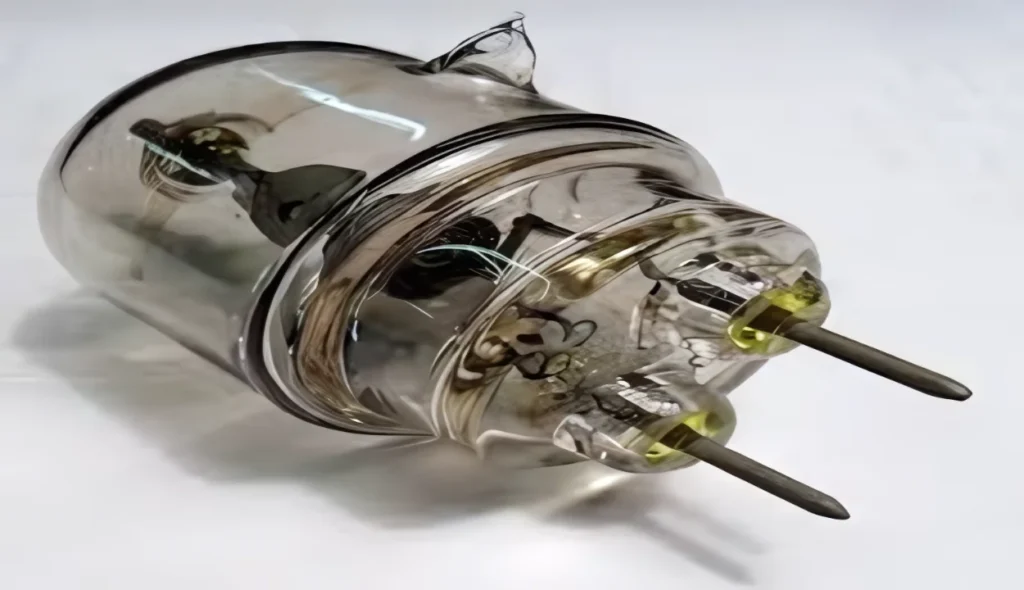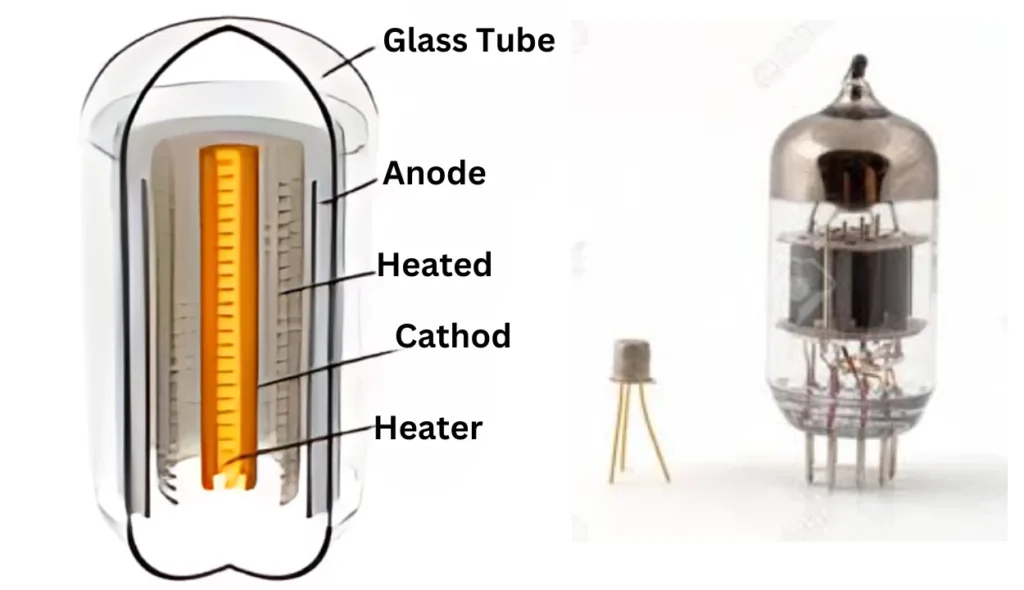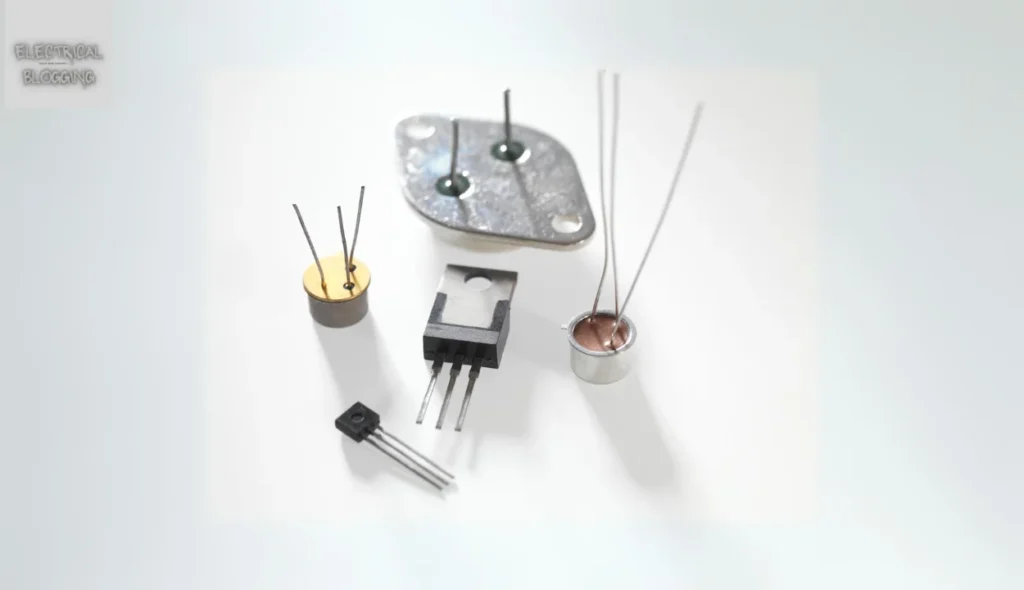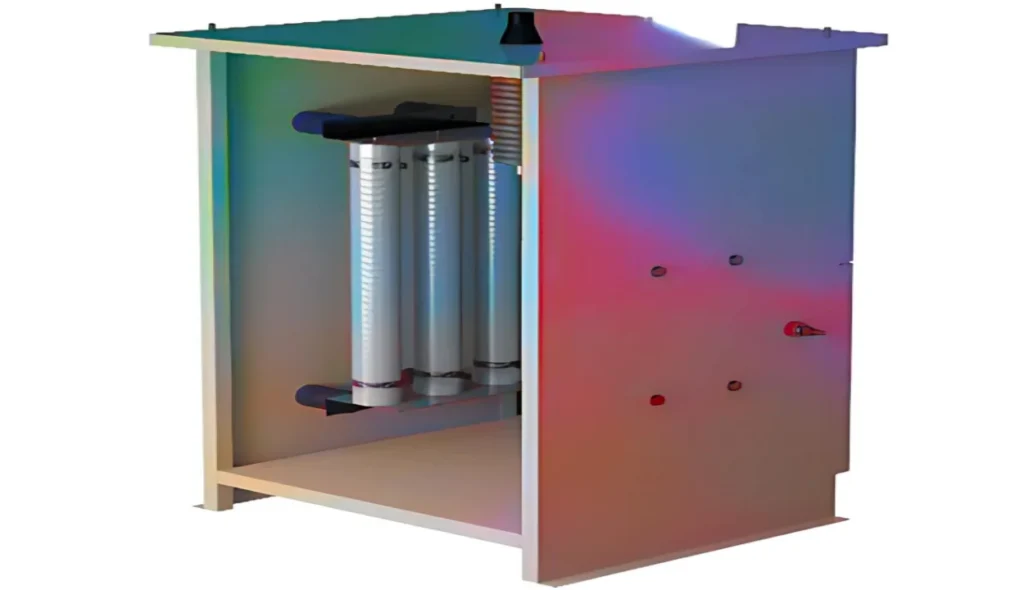Introduction
The vacuum diode was invented by the British scientist Sir John Ambrose Fleming in the year 1904. This device, also known as a Fleming valve, uses a thermionic tube with two electrodes — an anode and a cathode enclosed in a vacuum tube. This article provides an overview of its working and various applications.
From my experience, understanding the vacuum diode is crucial when learning about early electronics. The presence of tubes in these systems played a key role in shaping modern technology, and the Fleming valve was a groundbreaking discovery that simplified many complex electrical designs.
What is a vacuum diode?
A vacuum diode is a device that allows current to flow from the cathode to the anode, but blocks the flow in the opposite direction. The cathode acts as an emitter as it emits free electrons, while the anode serves as a collector by gathering these electrons. This simple yet powerful definition makes the vacuum diode well-known in electronics. You can also read Thermistor.
Vacuum Diode diagram
Construction of Vacuum Diode
The vacuum diode is the simplest form of a tube with two electrodes — an anode and a cathode inside a glass envelope. The cathode is often covered with barium oxide and strontium, which generate free electrons that leave the cathode and enter the anode. This setup allows electric current to flow in one direction only.
The anode is a hollow cylinder, often made from nickel or molybdenum, designed to dissipate heat effectively. It is constructed larger than the cathode to prevent an extreme increase in temperature. Cooling fins are arranged around the anode to remove excess heat and ensure stable performance.
An empty space exists between the two terminals, ensuring the current can travel freely without obstruction. The enclosed structure helps maintain the vacuum, improving efficiency and enhancing the diode’s lifespan. This precise design ensures the vacuum diode performs reliably in various applications. You can also read NTC Thermistor.
Working Principle of Vacuum Diode
The vacuum diode works on the thermionic emission principle, where heat is applied to the cathode. This process heats the metal, causing electrons to be generated and released. The anode attracts these free electrons only if a positive voltage is sufficient to pull them across.
The number of electrons released mainly depends on two factors: the amount of heat and the work function of the material. Metals like tungsten or oxide-coated emitters are frequently selected as they produce more emission with controlled heat. With less heat, fewer electrons are emitted.
The work function is defined as the minimum energy required to remove electrons from the metal. Materials with a high work function need more energy, while those with a low work function need less heat to release electrons. This balance directly affects the efficiency of the diode.
Choosing suitable metals like thoriated tungsten improves performance as they handle hot conditions effectively. These emitters are frequently used to enhance electron flow, ensuring stable operation even when temperatures rise. This precise design makes the vacuum diode reliable and efficient.
Vacuum Diode Circuit Diagram
Case 1: Forward Voltage
In a vacuum diode with a forward voltage setup, the heater is supplied with heat, which helps the cathode obtain ample energy. This energy causes electrons to split their bond with the cathode and move freely into the vacuum space. These free electrons need sufficient kinetic energy to arrive at the anode.
When a positive voltage is applied to the anode and a negative connection is made to the cathode, the electrons are attracted toward the anode. As these electrons flow, they carry electric current, which steadily enhances the performance of the circuit. The movement of electrons continues as long as the voltage is sufficient to maintain their motion.
If the voltage at the anode is increased, more electrons are drawn toward the terminal, causing the current to increase. This process ensures that the diode effectively controls the transmitted energy and maintains stable performance in the circuit.
Case 2: Reverse Voltage
In a vacuum diode with a reverse voltage setup, the anode is connected to the negative terminal, while the cathode is linked to the positive terminal. When voltage is applied, free electrons are generated at the cathode and attempt to shift toward the anode. However, the anode resists their movement, preventing current flow.
The anode is charged negatively, and since electrons are also negatively charged, they are repelled by the anode. This happens because objects with similar charges push each other away when located nearby. Consequently, the circuit prevents sufficient energy from reaching the anode, blocking the current.
Case 3: No Voltage
When no voltage is given to the vacuum diode, the anode remains neutral and does not attract or repel free electrons. As a result, the electrons produced by the cathode stay at the terminal without being moved toward the anode. This prevents any current flow within the circuit.
Over time, a huge number of electrons can build up near the cathode and form a cloud called a space charge. This cloud stays close to the cathode and acts as a barrier, further resisting the movement of generated electrons within the vacuum diode.
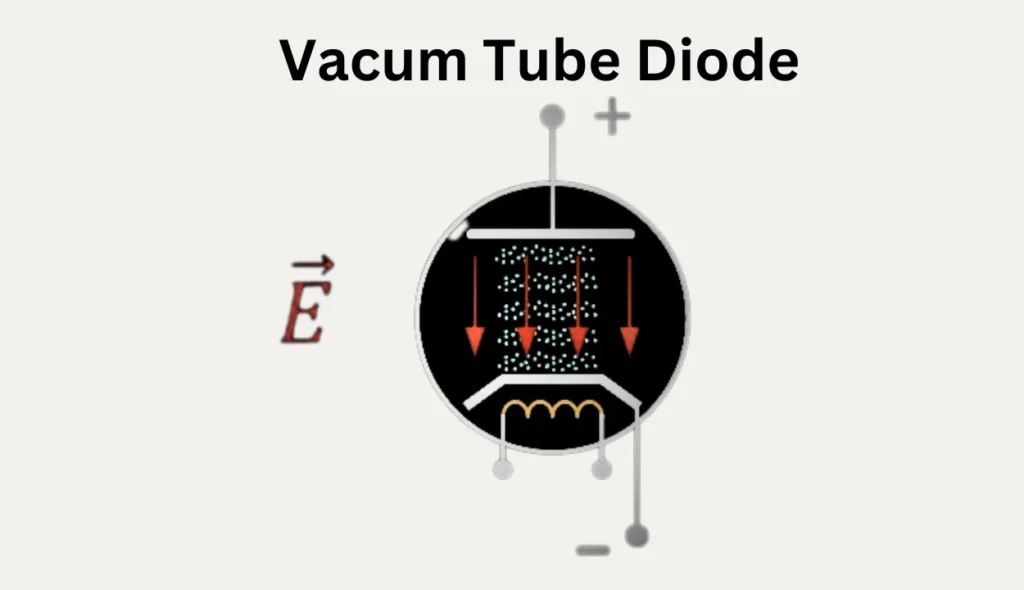
Vacuum Diode Characteristics
The characteristics of a vacuum diode are influenced by several factors. The electron emission from the cathode depends on the temperature and the voltage applied to the anode. As the cathode gets heated, the amount of electrons released increases. This process helps improve the current flow in the circuit.
A key factor is the space charge that forms near the cathode during electron emission. This charge acts as a barrier that restricts the electrons from reaching the anode. As the voltage increases gradually, the strength of this charge starts to decrease. This allows the current to increase in a controlled way.
In certain conditions, the diagram shows a limiting zone known as the characteristic region. Once this region vanishes, the electron emission becomes stable and directly dependent on the temperature. The graphs of these stages show performance differences at ToC, >ToC, and <ToC values.
In rare cases, the circuit may seem to have no voltage, but some electrons still reach the anode. This is caused by statistical fluctuations in the velocity of particles. This tiny amount of current is called splash current, and while small, it still plays a role in the vacuum diode’s performance.
Selection of vacuum diodes
Frequency Range: Vacuum diodes can operate at audio, radio, or microwave frequencies based on their design and construction.
Power Rating: They can be divided into small-signal or power diodes, depending on their ability to handle low or high levels of power.
Cathode/Filament Type: These diodes can have directly or indirectly heated cathodes, where the filament may be a separate part or included within the cathode itself.
Application-Based Diodes: They can be used for receiving, transmitting, or switching signals, depending on the required configuration and circuitry.
Specialized Parameters: Some diodes feature long life, low noise, microphony sensitivity, and improved efficiency, influenced by their specialized construction and materials.
Specialized Functions: Certain diodes perform specific tasks, such as radiation or light detection, video imaging, gas discharge, or plasma generation, due to their unique structure and operation.
Types of Vacuum Diodes
Rectifier Diode: This vacuum diode converts AC into DC by allowing current to flow in only one direction. It is often utilized in power supply circuits.
Detector Diode: This diode detects the presence or amplitude of a signal by producing a DC output that is proportional to the incoming signal strength.
Zener Diode: This vacuum diode operates in reverse bias and keeps the voltage across its terminals constant by breaking down at a set level when the voltage rises too high.
Varactor Diode: This diode acts as a variable capacitor by changing its capacitance based on the applied reverse voltage, making it ideal for tuning circuits.
Schottky Diode: This diode features a metal-semiconductor junction with a lower forward voltage drop and a faster switching speed than conventional diodes.
Conventional diodes: These are general-purpose diodes used in simple switching circuits and signal rectification, known for their stable performance in standard applications.
Applications of Vacuum Diodes
High-Power Applications: Vacuum diodes are used in microwave ovens, radar systems, and industrial heating due to their ability to handle higher currents and power without breaking or overheating.
High-Frequency Applications: Devices like klystron tubes, magnetrons, and wave tubes rely on vacuum diodes to operate efficiently at high frequencies, overcoming parasitic effects seen in semiconductor devices.
Audio Applications: Vacuum diodes are used in guitar amplifiers and high-end audio systems to produce a warmer, richer sound with nonlinear characteristics and harmonic effects.
High-Temperature Applications: Vacuum diodes work well in hot places like nuclear reactors and thermionic converters. They can handle high temperatures without melting. In contrast, solid-state devices tend to break down when exposed to heat.
Advantages and Disadvantages of Vacuum Diode
Advantages
Sound quality in vacuum diodes is better compared to that of other devices, giving a richer audio output.
These diodes’ characteristics are highly independent of temperature changes, ensuring stable performance.
As compared to transistors, they offer a wider dynamic range with a strong tolerance for overload.
Their circuits are simple to design, making them easier to build and maintain.
The capacitance in these devices changes only slightly with signal voltages, improving reliability.
Disadvantages
Vacuum diodes are bulky, making them less appropriate for portable devices.
They require higher operating voltages, which may lead to energy inefficiency.
These diodes consume more power than modern alternatives, like transistors.
Glass tubes used in these diodes are delicate and prone to damage.
The cost of vacuum diodes is high, adding expenses to applications that require them.
Difference between Vacuum Tube Vs Transistor
| Feature | Vacuum Tube | Transistor |
|---|---|---|
| Device Type | An electronic device that controls the flow of electrons. | A semiconductor device that can conduct and insulate electric current. |
| Size | Big in size, making it less suitable for compact designs. | Small in size, ideal for compact ICs and circuits. |
| Power Consumption | Consumes high power, causing more wastage of heat. | Consumes low power, resulting in less heat production. |
| Voltage Supply | Needs high voltage supply, limiting use in smaller devices. | Requires low voltage supply, suitable for smaller products. |
| Voltage Gain | Provides less voltage gain. | Delivers high voltage gain with better amplification. |
| Impedance | Has low input impedance. | Offers high input impedance for improved signal control. |
| Temperature Dependence | Less dependent on temperature variations. | Highly dependent on temperature, making heat control important. |
| Strength | Has low physical strength due to its fragile glass tube. | Provides high physical strength, making it more durable. |
| Applications | Preferred in high-power applications like industrial and radio systems. | Suitable for ICs, digital circuits, and portable devices. |
| Portability | Less suitable for portable designs due to its large size. | Highly appropriate for portable devices. |
| Replacement | Can be easily replaced by the user. | Difficult to be replaced by the user. |
| Cost | More expensive due to its complex design and glass materials. | Less expensive, offering cost-effective solutions. |
| Heat Handling | Less efficient in managing heat, leading to higher energy loss. | Efficient at handling heat, ensuring stable performance. |
Conclusion
The vacuum diode remains a significant component in electronics despite being largely replaced by semiconductor devices. Its unique advantages, such as better sound quality, wider dynamic range, and strong overload tolerance, make it ideal for specialized applications. However, factors like bulky size, higher power consumption, and delicate glass tubes limit its practicality in modern portable devices. Vacuum diodes still shine in high-power, high-frequency, or high-temperature applications. They often outdo solid-state devices, showing their ongoing importance in technology.

